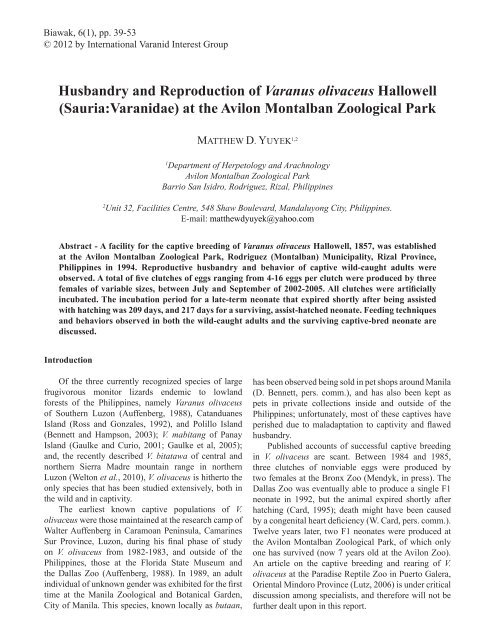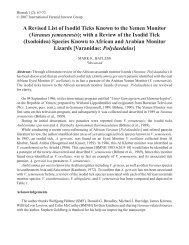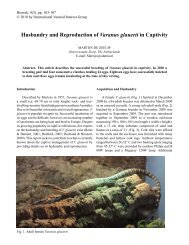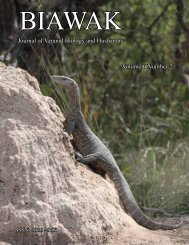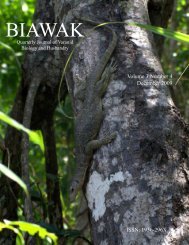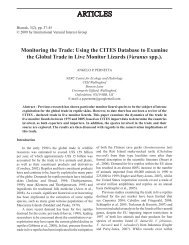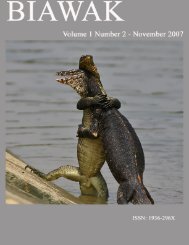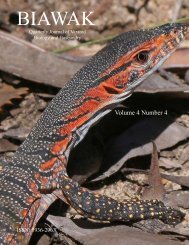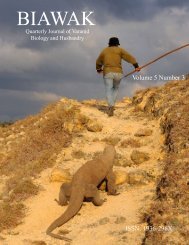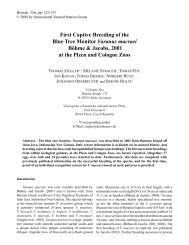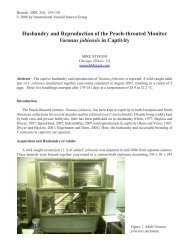Husbandry and Reproduction of Varanus olivaceus Hallowell ...
Husbandry and Reproduction of Varanus olivaceus Hallowell ...
Husbandry and Reproduction of Varanus olivaceus Hallowell ...
You also want an ePaper? Increase the reach of your titles
YUMPU automatically turns print PDFs into web optimized ePapers that Google loves.
BIAWAK VOL. 6 NO. 142peat filled to a depth <strong>of</strong> 15 cm. A drainage system wasinstalled behind the enclosures. Artificial boulders <strong>and</strong>tree branches made <strong>of</strong> cement were strategically placedto facilitate climbing, <strong>and</strong> shallow caverns <strong>and</strong> ledgeswere constructed to serve as tight-fitting retreats <strong>and</strong>basking sites. The ro<strong>of</strong>, also made <strong>of</strong> heavy duty steelmesh, was reinforced with 2.5 cm2 <strong>of</strong> chicken wire <strong>and</strong>partially covered with thick, transparent polyethylenesheeting to keep excessive rainwater from flooding theinterior <strong>of</strong> the enclosure <strong>and</strong> to allow access to naturalsunlight. The front <strong>of</strong> the enclosure was fitted with apanel <strong>of</strong> tempered glass (ca. 1.9 cm thick) to facilitateobservation without visual barriers.Individuals from Cat<strong>and</strong>uanes Isl<strong>and</strong> were keptseparate from those from the Bicol Peninsula, <strong>and</strong>were identifiable by their atypical ash-grey coloration(for comparison, see Fig. 2). Individuals purportedto have been collected from evergreen forests <strong>of</strong>the Bicol Peninsula (n=13) exhibited a pronouncedolive-green coloration whilst those from limestoneforests <strong>of</strong> Cat<strong>and</strong>uanes Isl<strong>and</strong> (n=5) surprisingly weredistinctly ash-grey in coloration. Variation in bodycoloration within species corresponding to colordifferences in habitat strata has also been observed inV. exanthematicus, where individuals inhabiting darksoils <strong>of</strong> the coastal plain <strong>of</strong> Ghana tend to be darker incoloration than those inhabiting lighter soils in Agomeda(Bennett & Thakoordyal, 2003). Gaulke (1991) alsomentioned differences in the coloration <strong>of</strong> V. nuchalisbetween animals from Negros <strong>and</strong> Panay Isl<strong>and</strong>s, <strong>and</strong>darker individuals from the isl<strong>and</strong>s <strong>of</strong> Masbate, Ticao,<strong>and</strong> Boracay. These color differences, however, are notattributed to the color <strong>of</strong> the substratum in their habitat,but rather the influence <strong>of</strong> geography. The variation incolor between V. <strong>olivaceus</strong> populations requires furtherstudy.Diet <strong>of</strong> captive adultsFeeding was initiated three days after the arrival<strong>of</strong> specimens. Food was <strong>of</strong>fered once every 2-3 daysbetween 0900 <strong>and</strong> 1000 h, after the lizards had basked.Chicken heads were stored in a freezer <strong>and</strong> thenthawed to room temperature before feeding. Thesewere apportioned to each individual (ca. 100-150 g perfeeding) <strong>and</strong> <strong>of</strong>fered in a large plastic basin. All uneatenfoods were removed after 1500 h.Apart from chicken heads, rodents such as laboratorymice (Mus musculus), fancy rats (Rattus norvegicus),<strong>and</strong> wild-caught Luzon field rats (R. argentiventer)were fed once or twice a month as supplementaryitems. Because M. musculus <strong>and</strong> R. norvegicus had tobe purchased from commercial breeders, only about 5%<strong>of</strong> those purchased were given to V. <strong>olivaceus</strong>, with theremaining 95% allocated to 112 snakes <strong>of</strong> 50 speciesmaintained at the Herpetarium during early operations<strong>of</strong> the zoo. The rodents were stunned before being fedto the lizards either in a plastic basin or by tease-feedingusing 62 cm long stainless steel hemostats.Daily cleaning <strong>of</strong> enclosures was usually carried outin the morning before feeding time. The water in the poolwas replenished daily; more <strong>of</strong>ten so if contaminatedwith feces or uneaten food. The top layer <strong>of</strong> the substratewas periodically scraped <strong>of</strong>f <strong>and</strong> replenished with freshmaterial.Egg incubationFig. 2. Color comparison between a Cat<strong>and</strong>uanes Isl<strong>and</strong>V. <strong>olivaceus</strong> (left) <strong>and</strong> a specimen from the Bicol Peninsula(right). Note the ashy-grey coloration <strong>of</strong> the Cat<strong>and</strong>uanesIsl<strong>and</strong> specimen.All clutches <strong>of</strong> eggs were laid in the evening <strong>and</strong>collected the following morning. Misshapen eggs <strong>and</strong>those submerged in the pool were discarded. Eggs weremarked <strong>and</strong> numbered with pencil to maintain the samepolarity as when they were laid. The eggs were measured(Table 2) with a vernier caliper <strong>and</strong> weighed using ahousehold gram scale before being placed in perforated<strong>and</strong> transparent plastic brood containers measuring 24X 12 X 16 cm. Moist rubber foam cubes 5 cm thickwere used as an incubation medium. The cubes were
43YUYEK - HUSBANDRY AND REPRODUCTION OF VARANUS OLIVACEUSTable 2. <strong>Varanus</strong> <strong>olivaceus</strong> eggs produced at the Avilon Zoo from 2002-2005. Values are expressedas mean (range).Female No. Date Laid Clutch size Length (mm) Diameter (mm) Weight (g)11 17-Jul-02 10 58.0 (51.0-65.3) 42.0 (40.3-42.8) 46.0 (40.5-52.3)16 5-Jul-03 6 56.2 (52.0-60.3) 38.9 (30.8-40.2) 39.6 (36.0-43.6)17 14-Jul-03 4 63.5 (59.3-66.2) 33.6 (32.6-35.2) 46.6 (44.7-48.6)11 25-Sep-03 13 69.8 (64.5-78.2) 40.5 (38.8-42.2) 56.8 (52.0-62.0)11 18-Sept-04 8 69.3 (63.3-75.5) 40.2 (38.5-42.3) 53.5 (48.6-60.0)Overall 8.2 (4-13) 64.2 (51.0-78.2) 39.9 (30.8-42.8) 50.0 (36.0-62.0)moistened with water to a ratio <strong>of</strong> 1:2 by weight. Theeggs were set firmly on the upper level <strong>of</strong> the cubes.The upper level was kept dry, the middle level relativelymoist, <strong>and</strong> the lower level perpetually submergedin water. Water at the bottom <strong>of</strong> the brood containerswas maintained at a height <strong>of</strong> 2.5 cm <strong>and</strong> refilled whennecessary. Additional moisture to increase relativehumidity was adjusted by misting the interior walls<strong>of</strong> the container <strong>and</strong> the upper level <strong>of</strong> the incubationmedia only. The egg containers were subsequentlyplaced in a custom-made acrylic box measuring ca.60 x 60 x 40 cm (l x w x h) with a perforated lid t<strong>of</strong>unction as an incubator. A 50 W inc<strong>and</strong>escent bulb wasinstalled in the upper-most corner <strong>of</strong> the incubator toprovide additional heat. The bulb was switched on inthe morning at 0600 h <strong>and</strong> <strong>of</strong>f in the evening at 1800 hover the course <strong>of</strong> incubation. The bulb was switched<strong>of</strong>f manually during the hottest part <strong>of</strong> the day <strong>and</strong>switched on once again if an increase in temperature wasnecessary. The egg containers were covered with sheets<strong>of</strong> newspaper to reduce the intensity <strong>of</strong> light striking theeggs. Temperature <strong>and</strong> humidity were monitored <strong>and</strong>recorded twice daily during the hottest hours <strong>of</strong> the day<strong>and</strong> coolest hours <strong>of</strong> the night using a digital, dual-typethermometer <strong>and</strong> hygrometer with thermal probes. Thethermal probes were placed directly on the surface <strong>of</strong>the eggs to record temperature <strong>and</strong> humidity readings.The incubator <strong>and</strong> egg containers were opened daily, ortwice a day if necessary, to facilitate the exchange <strong>of</strong>oxygen <strong>and</strong> to eliminate carbon dioxide build up duringembryonic development.Temperature <strong>and</strong> relative humidity for the 2003clutch were modified in the latter phase <strong>of</strong> incubation.Daytime temperature was reduced by 4-5 °C. Therelative humidity was reduced by 15-25%, but wasincreased again to 100% beginning on day 183 inattempt to restore moisture to the remaining two eggswhich had become severely indented (see Table 3).Assisted hatching <strong>of</strong> neonatesManual dissection following procedures describedby Ross & Merzec (1990) was performed on the twocritically indented eggs using a pair <strong>of</strong> 11.5 cm longstainless steel straight-tipped iris scissors. A small 2.5cm V-shaped slit was cut along the surface <strong>of</strong> each eggto check the physical condition <strong>of</strong> the neonate within.Both neonates were assisted out <strong>of</strong> the egg by using astainless steel sexing probe to stimulate motor functionby lightly touching the tip <strong>of</strong> the probe to the body. Ittook neonate #1 more than 30 min <strong>and</strong> neonate #2 lessthan 10 min to emerge. Upon emerging, the two assisthatchedneonates were placed in previously disinfectedbrood containers with cotton sheeting as a substrate,dampened with 70% ethyl rubbing alcohol to preventinfection <strong>of</strong> the fresh umbilical scar in neonate #1<strong>and</strong> the unabsorbed yolk sac in neonate #2. Surgicalprocedures were performed immediately to separate theunabsorbed yolk sac from the yolk stalk <strong>of</strong> the survivingneonate #2 (E.B. Maestro, unpub. dat.) to prevent theyolk sac from being dragged about the tank. The freshumbilical scars <strong>of</strong> both neonates were dabbed withPovidone-Iodine. Neonate #1 expired 1 h 45 min afterbeing assisted out <strong>of</strong> the egg. The yolk sac, measuring3.3 cm in diameter, was preserved in 70% ethyl rubbingalcohol, <strong>and</strong> the carcass <strong>of</strong> the neonate was preserved ina 33% formalin solution (ID: AZCBMu001-03-00162);both were deposited at the Animal Hospital <strong>of</strong> AvilonZoo.Neonate #2 was transferred to the RearingDepartment <strong>and</strong> placed in an acrylic rearing tankmeasuring 60 x 30 x 30 cm (l x w x h) for post-surgerycare <strong>and</strong> observation. Newspaper was used as substrate.Water was provided in a small, shallow ceramic cup.A Y-shaped tree branch was placed at an angle sothat the forked end was 5 cm beneath the wire meshcover. The rearing tank <strong>and</strong> all materials within it were
BIAWAK VOL. 6 NO. 146probing is unreliable (Andrews & Gaulke, 1990; Card,1995; Gaulke et al., 2005). Radiography, one <strong>of</strong> thereliable methods for accurately sexing V. <strong>olivaceus</strong>, wasdescribed by Card (1995). In addition, Auliya & Erdelen(1999) explained that radiographing the hemibacula isnot a reliable method for all varanid species. Due tothe lack <strong>of</strong> radio-opaque tissues, V. salvator cannot bereliably sexed using radiography (Card & Kluge, 1995).Conclusive sex determination is best achieved by usingendoscopy (Schildger & Wicker, 1992; Schildger et al.,1993; D. Bennett, pers. comm.). In contrast to theseabove-mentioned methods, all V. <strong>olivaceus</strong> at the AvilonZoo had been sexed using traditional methods (e.g.,hemipeneal probing <strong>and</strong> comparison <strong>of</strong> morphologicaldifferences) since endoscopy <strong>and</strong> radiography wereinaccessible at that time, <strong>and</strong> 80% <strong>of</strong> the determinedgenders were found to be correct.Reproductive behaviors were observed from 1995-2004. Pre-copulatory interactions began in May <strong>and</strong>continued throughout the rainy months <strong>of</strong> June, July, <strong>and</strong>August. Similar interactions were also observed duringthese months in other varanids at the zoo, including V.marmoratus (Yuyek, unpub. dat.; N.H. Margarico, per.comm.), V. cumingi (Yuyek, 2004c), V. exanthematicus(Yuyek, 2005a), V. salvadorii <strong>and</strong> V. bengalensisnebulosus (Yuyek, unpub. dat.).Ritualistic bipedal combat between male V.<strong>olivaceus</strong> reported by Auffenberg (1988) was notobserved in the 2002 breeding group when two maleswere housed together with two females. Observations<strong>of</strong> most breeding attempts indicated that breedingmales <strong>and</strong> females regularly stayed in close contact toone another for several days prior to the onset <strong>of</strong> actualcourtship. Courtship was observed to have always beeninitiated by the male <strong>and</strong> would continue sporadicallyfor a period <strong>of</strong> 2-3 weeks. During the breeding season <strong>of</strong>1995, it was noted that courting male #1 exhibited muchgreater interest in the larger female #3 than the smallerfemale #2, persistently following female #3 around theenclosure, flicking its tongue along her tail base, <strong>and</strong>staying close together. Auffenberg (1988) describedcohabitation in wild V. <strong>olivaceus</strong>; however, it is unknownwhether male #1 <strong>and</strong> female #3 had been cohabiting inthe wild prior to being captured. It was also suspectedthat female #2 was probably non-receptive at the time<strong>of</strong> this courtship. Female #2 avoided these two sexuallyactive individuals by retreating to, <strong>and</strong> curling up in thecorner <strong>of</strong> the enclosure during the peak <strong>of</strong> courtshipactivities, <strong>and</strong> never ascended the tree branches. Thissubmissive behavior in smaller, non-receptive femaleswas also observed in captive V. cumingi (1:3 male t<strong>of</strong>emale ratio) during the breeding season in 2007. The V.cumingi male’s sexual interest was directed at the largerfemale <strong>of</strong> the group at all times. Smaller females tendedto move away when approached by the larger female,<strong>of</strong>ten retreating to a nearby shelter <strong>and</strong> remaining therefor days without showing interest in food (pers. obs.).Copulation in captive V. <strong>olivaceus</strong> was opportunisticallyobserved in 1995, 2003, <strong>and</strong> 2004, but was <strong>of</strong>teninterrupted by human activity around the enclosure.Dominance <strong>and</strong> aggression similar to those seen inmale varanids were not observed in any captive femaleV. <strong>olivaceus</strong>, but were observed in other varanid speciesat Avilon Zoo, <strong>and</strong> size appears to be a major factor. Forexample, conspecific aggression in V. cumingi occurredafter the introduction <strong>of</strong> a non-resident female to theenclosure <strong>of</strong> a resident male during the breeding season<strong>of</strong> 2003 (Yuyek, 2004c). Aggression was initiated by thefemale at the very instance when the male attempted tomount the female. As a result, the left hind foot <strong>of</strong> thefemale was severely mutilated from bites inflicted bythe male <strong>and</strong> had to be amputated. Eleven days afteramputation, the female died from a systemic infection,<strong>and</strong> egg follicles were retrieved from the oviducts duringnecropsy (E.B. Maestro, unpub. dat.). Engle (unpub. m.s.) observed aggressive behavior in a gravid female V.keithornei towards males <strong>and</strong> other females, <strong>and</strong> femaledominance behavior has also been observed in captive V.marmoratus <strong>and</strong> V. bengalensis nebulosus (pers. obs.).In the 1994 V. <strong>olivaceus</strong> breeding stock, precopulatoryinteractions took place unexpectedly on29 July <strong>and</strong> continued sporadically until 17 August.Copulation was observed in the morning <strong>of</strong> 18 August1995 between male #1 <strong>and</strong> female #3 (Table 5). Dueto the shy nature <strong>of</strong> V. <strong>olivaceus</strong> (Bennett, 2005),observations were made at a distance <strong>of</strong> ca. 3 m fromthe enclosure whilst the pair was engaged in copulation.Copulation was not repeated with the same female orattempted with the smaller female afterwards.Despite a noticeable enlargement <strong>of</strong> the female’sabdomen in the following months, oviposition didnot occur. <strong>Varanus</strong> <strong>olivaceus</strong>, both in the wild <strong>and</strong> incaptivity, have never been reported to consume their owneggs, the eggs <strong>of</strong> conspecifics, or those <strong>of</strong> other animals.Although ovophagy appears to be a common dietarycharacter in other monitor species (e.g., Arbuckle,2009; Cota, 2011), it is unlikely to occur in V. <strong>olivaceus</strong>.Therefore, it is doubtful that eggs were laid <strong>and</strong> theneaten. No reports on the resorption <strong>of</strong> oviductal eggsin gravid V. <strong>olivaceus</strong> exist at the time <strong>of</strong> this writing,although it has been reported in other species <strong>of</strong> reptiles(Blackburn, 1998).
47YUYEK - HUSBANDRY AND REPRODUCTION OF VARANUS OLIVACEUSTable 5. Copulatory data for V. <strong>olivaceus</strong> at Avilon Zoo.Year Male No. Female No. Date TimeDuration <strong>of</strong>CopulationTemperature (°C) RH (%)WeatherCondition1995 1 3 18-Aug 1045 h 8 min 15 s 29.6 78 Sunny2003 9 11 8-Aug 0610 h 9 min 20 s 26.5 72 Overcast10-Aug 0645 h 7 min 06 s 27.6 74 Raining11-Aug 0710 h 11 min 25 s 30.2 82 Sunny14-Aug 0620 h 4 min 03 s 26.2 77 Raining21-Aug 0605 h 6 min 42 s 27.5 70 Overcast2004 18 11 2-Aug 1415 h 10 min 28 s 29.5 72 Sunny5-Aug 0810 h 4 min 55 s 26.5 77 SunnyBreeding attempts were temporarily suspended from1998 until 2001 due to high mortality rates when threeadults <strong>and</strong> two sub-adults from the 1995 brood stockdied <strong>of</strong> chronic respiratory tract infections between 1997<strong>and</strong> 2000. Clinical signs resembled that <strong>of</strong> inclusionbody disease (IBD), a commonly encountered viralinfection in the family Boidae (Stahl, 1996). Conclusivediagnosis could not be determined due to the absence <strong>of</strong>a veterinary staff <strong>and</strong> laboratory at that time.Breeding attempts were reinstated in early 2002.Although copulation was not observed in those pairsfrom the 1998 breeding stock (male #7 <strong>and</strong> female #12;male #9 <strong>and</strong> females #11), 10 eggs were found scatteredon the substrate by female #11 (R. Madriaga, pers. obs.)<strong>and</strong> 6 were submerged in the pool. These eggs began todecompose after 15 days <strong>of</strong> incubation.In early July 2003, two separate cases <strong>of</strong> ovipositionwere observed in two young adult females (#16 <strong>and</strong>#17) from Cat<strong>and</strong>uanes Isl<strong>and</strong> that were housed withmale #15. A number <strong>of</strong> misshapen eggs were laidin both clutches. Three weeks prior to oviposition,sporadic courtship interactions between individualswere observed. On 5 July 2003, female #16 depositeda clutch <strong>of</strong> six eggs, with an additional five eggs, all <strong>of</strong>which were misshapen, laid three days later. A clutch <strong>of</strong>seven eggs was laid by female #17 on 14 July, <strong>of</strong> whichfour appeared viable. Eggs from both clutches (A <strong>and</strong> B)were simultaneously incubated in the same manner asthat used for the 2002 clutch. These eggs became flaccid<strong>and</strong> began to sweat on the third day <strong>of</strong> incubation <strong>and</strong>eventually began to deteriorate, becoming infested withmaggots by day 10.The zoo’s third breeding attempt between male #9<strong>and</strong> female #11 began in late June 2003. These individualswere selected on the basis <strong>of</strong> pre-copulatory behaviorsobserved after being introduced to one another. Female#11 was removed from Cage A <strong>of</strong> the outdoor enclosure<strong>and</strong> transferred to the newly constructed outdoor exhibitenclosure. Four weeks prior to the onset <strong>of</strong> monsoonrains, male #9 was introduced to the female. Vigorouscourtship activities began on 30 July <strong>and</strong> continuedinfrequently for another two weeks. Copulation wasobserved on 8 August at 0610 h <strong>and</strong> lasted 9 min 20s. Temperature <strong>and</strong> humidity inside the enclosureat this time was 26.5 °C <strong>and</strong> 72%, respectively. Foursubsequent copulations were observed, ending on 21August (Table 5).Another breeding attempt using male #18 <strong>and</strong> female#11 was carried out on 2 August 2004. After copulationswere observed <strong>and</strong> the female had lost sexual interest,the male was removed from the enclosure. Althoughfrequently investigated, a hollow coconut palm trunknest box was ignored by the gravid female, <strong>and</strong> eighteggs were deposited atop the substrate. The eggs wereincubated in the same manner used for the clutch in2003, but decomposed shortly thereafter (Fig. 3).Copulatory positions in <strong>Varanus</strong> are generallysimilar to those exhibited by other lizards includingthe families Iguanidae, Agamidae, Gekkonidae, <strong>and</strong>Scincidae. Captive male V. <strong>olivaceus</strong> usually mountedsubmissive females from behind, following a series <strong>of</strong>jerking head movements, tongue flicking, <strong>and</strong> scratching<strong>of</strong> the female’s body along the head, neck <strong>and</strong> back.Males differed in their usage <strong>of</strong> the hemipenes duringcopulation; male #1 in 1995 <strong>and</strong> male #7 in 2003 usedthe right hemipenis, whereas male #18 in 2004 used theleft. Copulation always occurred on l<strong>and</strong> <strong>and</strong> never inwater as observed in V. cumingi (Wicker et al., 1999;Yuyek, 2007, pers. obs.) <strong>and</strong> V. salvator macromaculatus(Cota, 2011).
BIAWAK VOL. 6 NO. 148Table 6. Comparison <strong>of</strong> egg production in captive <strong>Varanus</strong> at Avilon Zoo 1995-2008.Species No. females YearNo. eggslaidNo. incubatedNo.hatchedNo. <strong>of</strong>survivinghatchlingsCommentsmarmoratus 1 2002 8 8 5 5 Captive-hatched from wildcollectedeggscumingi 1 2002 8 5 - - Three full term embryos diedin egg; in preservativeexanthematicus 1 2003 12 6 5 3 Captive-bred <strong>and</strong> hatched<strong>olivaceus</strong> 6 1995 10 41 2 1 One hatchling died shortly2003 23after being assisted hatched; inpreservative2004 8salvadorii 1 2007 4 4 - - Mated in captivityUnlike other varanid species that deposit their eggsin burrows dug in the ground (e.g., Wicker et al., 1999;Dwyer & Perez, 2007; Coiro, 2007; Visser, et al., 2009)or in termite mounds (e.g., Bennett & Thakoordyal,2003), hollow tree trunks are probably utilized as nestingsites by V. <strong>olivaceus</strong> in the wild. Despite having variousnest sites provided, egg deposition atop the substrate hasalso been observed in V. keithornei (Engle, unpub. m.s.),<strong>and</strong> is identical to the egg laying behavior <strong>of</strong> captiveV. <strong>olivaceus</strong> at Avilon Zoo. This abnormal behavior islikely related to insufficient nest sites or nesting options.Clutch sizes, egg morphometrics, <strong>and</strong> incubationCommunal housing <strong>of</strong> 1.2 (males.females) V.<strong>olivaceus</strong> in 1995, 2.2 in 2002, 1.2 in 2003, <strong>and</strong> 1.1 in2004 resulted in zero egg production in 1995 <strong>and</strong> nonviableeggs in 2002, 2003 <strong>and</strong> 2004. A total <strong>of</strong> fiveclutches (n=64) were produced by the three femalesbetween 2002 <strong>and</strong> 2005 (Table 5). Single clutches <strong>of</strong> 16,16, <strong>and</strong> 14 eggs were laid by the same female (#11) on17 July 2002, 25 September 2003, <strong>and</strong> 18 September2004, respectively. In addition, single clutches <strong>of</strong> eleven<strong>and</strong> seven eggs were laid by two Cat<strong>and</strong>uanes females(#16 <strong>and</strong> #17) on 5 <strong>and</strong> 14 July 2003, respectively. Ofthe 64 eggs produced, 23 were either misshapen orfound submerged in the pond. The average number <strong>of</strong>viable eggs (n=41) per clutch was 8 (range 4-13), withan average <strong>of</strong> 20 eggs received per year. Mean <strong>and</strong>overall range in egg length, diameter, <strong>and</strong> weight was64.2 mm (51.0-78.2), 39.9 mm (30.8-42.8), <strong>and</strong> 50.0g (36.0-62.0), respectively. Table 6 compares clutchesproduced by captive varanids at the Avilon Zoo.Reptilian clutch size is <strong>of</strong>ten associated with the size<strong>and</strong> age <strong>of</strong> a female (Auffenberg, 1988; Sumiller, 1998).Card (1994) reported double-clutching in V. <strong>olivaceus</strong> atthe Dallas Zoo. Multi-clutching (e.g., Retes & Bennett,2001; Bennett & Thakoordyal, 2003; Mendyk, in press),parthenogensis (Lenk et al., 2005; Hennessy, 2010), <strong>and</strong>twinning (e.g., Mendyk, 2007) were not observed in V.<strong>olivaceus</strong> or any other varanid species at the zoo.Using foam rubber cubes to incubate reptilian eggswas described by Schmidt (1995). Eggs <strong>of</strong> variousspecies <strong>of</strong> snakes <strong>and</strong> lizards have been successfullyhatched at the Avilon Zoo using this method (Yuyek,2004b, 2005a, 2006). Reptile eggs incubated at thezoo using a mixture <strong>of</strong> fluvial s<strong>and</strong>, coco peat, pottingFigure 3. Deteriorating eggs <strong>of</strong> V. <strong>olivaceus</strong> laid in 2005.Photograph courtesy <strong>of</strong> Neil Hendrix Margarico.
49YUYEK - HUSBANDRY AND REPRODUCTION OF VARANUS OLIVACEUSsoil, <strong>and</strong> humus resulted in high egg mortality, exceptfor those <strong>of</strong> Python reticulatus which were maternallybrooded on soil substrate (Yuyek, 2004d).Eggs <strong>of</strong> V. <strong>olivaceus</strong> laid between 2002 <strong>and</strong> 2004were artificially incubated in a similar fashion to themethods described by Andrews & Gaulke (1990) forV. salvator, except for the type <strong>of</strong> incubation mediumused, which followed Schmidt (1995). Most eggs,however, began to deteriorate within the first 10 days<strong>of</strong> incubation, probably due to infertility or since alleggs were not nested properly. Several factors, suchas inadequate nesting sites or eggs that were held toolong by the female might have contributed to poor eggsuccess during incubation. The lack <strong>of</strong> egg viabilityfor the two clutches laid by Cat<strong>and</strong>uanes females (#16<strong>and</strong> #17) was most likely associated with poor nestingconditions since nesting areas were not provided <strong>and</strong> theeggs were laid on the floor <strong>of</strong> the steel holding cage.Auffenberg (1988) reported that spermatogenesis inmale V. <strong>olivaceus</strong> is largely influenced by seasonality,<strong>and</strong> takes place from July through September, with Mayto July being peak months. Courtship <strong>and</strong> copulatorybehaviors in captive V. <strong>olivaceus</strong> at the Avilon Zo<strong>of</strong>rom 2002-2004 coincided with these months whenspermatogenesis is greatest.Assisted hatchingMany eggs from the September 2003 clutch(n=13) began to deteriorate during the early stages <strong>of</strong>incubation. On day six, egg #s 2, 3, 9, <strong>and</strong> 11 appeareddiscolored <strong>and</strong> bloated, <strong>and</strong> by day 14, all but egg #s 4,7, <strong>and</strong> 8 had deteriorated. Egg #4 deteriorated after 102days <strong>of</strong> incubation. No near-term embryos were foundin any <strong>of</strong> the deteriorated eggs.On Day 182, depressions started to develop in theremaining two eggs (#7& 8), with the denting in egg#7 more severe than that <strong>of</strong> egg #8. Humidity insidethe egg container was increased to 100% under theassumption that doing so would restore moisture tothe eggs; however, despite this increase, no significantchanges in the egg were observed. In contrast to the 214day incubation period recorded at the Dallas Zoo (Card,1995), V. <strong>olivaceus</strong> incubation at the Avilon Zoo took209 <strong>and</strong> 217 days, under the modified incubation setting.On Day 209, a decision was made to manually openthe first egg to prevent the neonate from dying inside.Upon dissection, the late-term neonate was found lodgedbetween its large, unabsorbed yolk sac <strong>and</strong> the indentedportion <strong>of</strong> the egg. After it was freed from the egg,neonate #1 showed poor prognosis in neuromuscular<strong>and</strong> respiratory functions <strong>and</strong> expired 3 h 45 min later,despite efforts to prolong its life.Neonate #2 was also assisted with hatching in thesame manner as neonate #1. Upon its emergence, vitalsigns appeared normal, except for the attached yolk sacthat required immediate ligation (Figs. 4 & 5). Engle(unpub. ms.) reported unabsorbed yolk syndrome in acaptive-bred V. keithornei, which was also surgicallyligated. The respiratory rate <strong>of</strong> neonate #2 was recordedat 10 breaths per min (E.B. Maestro, unpubl. dat.).The low hatch rate <strong>of</strong> V. <strong>olivaceus</strong> eggs may suggestflaws in captive diets for adults as well as incubationtechniques. <strong>Husb<strong>and</strong>ry</strong> <strong>and</strong> reproductive managementpractices were based largely on trial <strong>and</strong> error due a lack<strong>of</strong> comprehensive literature on the keeping <strong>and</strong> breeding<strong>of</strong> frugivorous monitor lizards.Neonatal coloration <strong>and</strong> patternThe coloration <strong>and</strong> pattern <strong>of</strong> neonatal V. <strong>olivaceus</strong>are different from that <strong>of</strong> adults. The upper half <strong>of</strong> theFigs. 4 & 5. The assist-hatched captive-bred V. <strong>olivaceus</strong> with attached yolk sac minutes after emergence.
BIAWAK VOL. 6 NO. 150dorsum is yellowish-brown in ground color <strong>and</strong> speckledwith tiny black spots, with five solid black transverseb<strong>and</strong>s extending from the nuchal to axilla regions (Figs.6 & 7). The lower half <strong>of</strong> the dorsum is black in groundcolor with numerous irregular bluish-white spotsforming seven light, irregularly-spaced transverse b<strong>and</strong>sthat terminate at the dorsolateral region. The upper <strong>and</strong>lower labials are splashed with bright orange coloration.The cranium is bright olive green with tiny black spots,<strong>and</strong> a distinct black temporal stripe extends from thepostocular to the anterior part <strong>of</strong> the ear. The forelimbs<strong>and</strong> hind limbs are bluish-black with numerous tinywhite spots, <strong>and</strong> the base color <strong>of</strong> the tail is solid blackwith 8-15 distinct white b<strong>and</strong>s. The underside <strong>of</strong> thehead <strong>and</strong> throat <strong>and</strong> the venter are tannish grey with thintransverse grey b<strong>and</strong>s (Fig. 8).Rearing <strong>of</strong> the captive-bred neonateSelecting specific types <strong>and</strong> quantities <strong>of</strong> food itemsfor the neonatal V. <strong>olivaceus</strong> was initially problematic inthat there appears to be a slight difference in the dietarypreferences between this species <strong>and</strong> other neonatalvaranids. It is likely that neonatal varanids have similardietary preferences for insects <strong>and</strong> other invertebrates,then transition to different food items when a certainsize or level <strong>of</strong> maturity is reached. Acheta domesticalet loose on the tank floor were ignored by the neonate,but were later accepted when <strong>of</strong>fered in feed cups.Hermann (1999) reported similar observations, wheresome captive-bred neonatal V. salvator would only takefood from feed cups.The neonate did not show any interest in solid fooduntil day 17. The first food items taken from the feedcups were three recently molted Z. morio, followedby five A. domestica, <strong>and</strong> finally, one small chunk <strong>of</strong>beef <strong>and</strong> two small chunks <strong>of</strong> chicken after they weretongue-flicked several times. Olfaction appeared to bemore important to V. <strong>olivaceus</strong> for detecting prey thaneyesight, which agrees with observations made onjuvenile V. exanthematicus (Bennett, 2000).The maximum skin temperature recorded for theneonatal V. <strong>olivaceus</strong> during thermoregulation at 0945h was 41.3 °C (E.B. Maestro, unpub. dat.). When thismaximum body temperature was achieved, the neonatemoved away from the basking spot; even if it wasrepeatedly returned to the same place by the keeper. Corebody temperatures were not recorded due to the fragilecondition <strong>of</strong> the neonate. The lighter head coloration <strong>of</strong>the individual <strong>and</strong> its wide dorsal b<strong>and</strong>s speckled withirregular, tiny white spots are presumably capable <strong>of</strong>reflecting solar radiation, enabling a higher degree <strong>of</strong>tolerance to solar radiation exposure than other specieswith darker overall body coloration. Captive V. <strong>olivaceus</strong>adults at the Avilon Zoo weighing 4.2-8.6 kg have beenrecorded thermoregulating at a range <strong>of</strong> 39.5-40.2 °Cfor durations <strong>of</strong> up to four hours without showing signs<strong>of</strong> heat distress (pers. obs.). Auffenberg (1988) reportedFigs. 6 & 7. Dorsal coloration <strong>and</strong> pattern <strong>of</strong> captive-bred neonatal V. <strong>olivaceus</strong>.
51YUYEK - HUSBANDRY AND REPRODUCTION OF VARANUS OLIVACEUSReferencesFig. 8. Fresh umbilicus <strong>and</strong> ventral coloration <strong>and</strong> pattern<strong>of</strong> captive-bred neonatal V. <strong>olivaceus</strong>.heat distress in V. <strong>olivaceus</strong> (age not specified) at a range<strong>of</strong> 41.6-42.4 °C.Acknowledgments - I thank Daniel Bennett, Robert W.Mendyk, Maren Gaulke, <strong>and</strong> two anonymous reviewersfor reviewing an early draft <strong>of</strong> this manuscript <strong>and</strong> forproviding valuable comments <strong>and</strong> additional literature.I also thank Joaquin Gaw <strong>of</strong> Avilon Zoo for his support<strong>and</strong> encouragement, <strong>and</strong> the staff <strong>of</strong> the Department <strong>of</strong>Herpetology <strong>and</strong> Arachnology <strong>of</strong> Avilon Zoo (1995-2007) for assistance during all phases <strong>of</strong> breedingoperations. Winston Card, William Oliver, EleanorB. Maestro, Christian Cruz, Percibal Hidalgo, NeilHendrix Margarico, Emerson Sy, Nonie Dolera, <strong>and</strong>Ronnie Sumiller are likewise gratefully acknowledgedfor providing additional information <strong>and</strong> support duringthe preparation <strong>of</strong> this manuscript.Andrews, H.V. & M. Gaulke. 1990. Observationson the reproductive biology <strong>and</strong> growth <strong>of</strong> thewater monitor (<strong>Varanus</strong> salvator) at the MadrasCrocodile Bank. Hamadryad 15(1): 1-5.Arbuckle, K. 2009. Ecological function <strong>of</strong> venom in<strong>Varanus</strong>, with a compilation <strong>of</strong> dietary recordsfrom the literature. Biawak 3(2): 46-56.Auffenberg, W. 1988. Gray’s Monitor Lizard.University Press <strong>of</strong> Florida, Gainsville. 416 pp.Auliya, M.A. & W. Erdelen. 1999. A field study<strong>of</strong> the water monitor lizard (<strong>Varanus</strong> salvator) inWest Kalimantan, Indonesia - new methods <strong>and</strong>old problems. Pp. 247-266. In Horn, H.-G. &W. Böhme (eds.), Advances in Monitor ResearchII, Mertensiella 11. Deutsche Gesellschaft fürHerpetologie und Terrarienkunde e.V., Rheinbach.Bennett, D. 2000. Preliminary data on the diet <strong>of</strong>juvenile <strong>Varanus</strong> exanthematicus (Sauria:Varanidae) in the Coastal Plain <strong>of</strong> Ghana.Herpetological Journal 10: 75-76.Bennett, D. 2002. Diet <strong>of</strong> juvenile <strong>Varanus</strong> niloticus(Sauria:Varanidae) on the Black Volta River inGhana. Journal <strong>of</strong> Herpetology 36(1): 116–117.Bennett, D. 2005. Polillo Butaan Project: 2002-2005Summary. The Ecology <strong>of</strong> <strong>Varanus</strong> <strong>olivaceus</strong> onPolillo Isl<strong>and</strong> <strong>and</strong> Implications for GiantFrugivorous Lizards in the Philippines. MampamConservation, Glossop, 40 pp.Bennett, D. & K. Hampson. 2003. Further observations<strong>of</strong> <strong>Varanus</strong> <strong>olivaceus</strong> on Polillo. In K. Hampson etal.Wildlife <strong>and</strong> Conservation in the PolilloIsl<strong>and</strong>s. Final Report. Multimedia CD. ViperPress, Glossop.Bennett, D. & R. Thakoordyal. 2003. TheSavannah Monitor Lizard - The Truth About<strong>Varanus</strong>exanthematicus. Viper Press, Glossop.84 pp.Blackburn, D.G. 1998. Resorption <strong>of</strong> oviductal eggs<strong>and</strong> embryos in squamate reptiles. HerpetologicalJournal 8(2): 65-71.Card, W. 1994. Double clutching Gould’s monitors(<strong>Varanus</strong> gouldii) <strong>and</strong> Gray’s monitor (<strong>Varanus</strong><strong>olivaceus</strong>) at the Dallas Zoo. HerpetologicalReview 25: 111-114.Card, W. 1995. Gray’s monitor lizard (<strong>Varanus</strong><strong>olivaceus</strong>) at the Dallas Zoo. Reptiles 3(5):78-85.Card, W. & A.G. Kluge. 1995. Hemipeneal skeleton<strong>and</strong> varanid lizards systematics. Journal <strong>of</strong>Herpetology 29(2): 275-280.
BIAWAK VOL. 6 NO. 1 52Coiro, J. 2007. Captive breeding <strong>of</strong> <strong>Varanus</strong>exanthematicus. Biawak 1(1): 29-33.Cota, M. 2011. Mating <strong>and</strong> intraspecific behavior<strong>of</strong> <strong>Varanus</strong> salvator macromaculatus in an urbanpopulation. Biawak 5(1/2): 17-23.Cowie, R.H. 2006. Apple Snails as Agricultural Pests:Their Biology, Impact, <strong>and</strong> Management. A ProjectSummary, 26 pp. http://www.cdfa.ca.gov/phpps/ppd/Entomology/Snails/AMPchap.htm. (Lastaccessed 20.08.11).Gaulke, M. 1991. Systematic relationships <strong>of</strong>the Philippine water monitors as compared with<strong>Varanus</strong> salvator, with a discussion <strong>of</strong> dispersalroutes. Pp. 154-165. In Böhme, W. & H.-G. Horn(eds.), Advances in Monitor Research, Mertensiella2. Deutsche Gesellschaft für Herpetologie undTerrarienkunde e.V., Rheinbach.Gaulke, M. & E. Curio. 2001. A new monitor lizardfrom Panay Isl<strong>and</strong>, Philippines. Spixiana 24: 275-286.Gaulke, M., A.V. Altenbach, A. Demegillo & U.Struck. 2005. On the distribution <strong>and</strong> biology<strong>of</strong> <strong>Varanus</strong> mabitang. Silliman Journal 46(1): 89-117.Dwyer, Q. & M. Perez. 2007. <strong>Husb<strong>and</strong>ry</strong> <strong>and</strong>reproduction <strong>of</strong> the black water monitor, <strong>Varanus</strong>salvator komaini. Biawak 1(1): 13-20.Engle, K. Undated. Breeding behaviour <strong>of</strong> the canopygoanna (<strong>Varanus</strong> keithornei).http://www.australiazoo.com.au/conservation/publications/breeding%20behaviour%20<strong>of</strong>%20the%20canopy%20goanna.pdf. (Last accessed 28.06.11).Hairston, N.G. 1965. Statistical analysis <strong>of</strong>molluscicide field trials. Bullletin <strong>of</strong> the WorldHealth Organization 32: 289-296.Hennesy, J. 2010. Parthenogenesis in an ornate Nilemonitor, <strong>Varanus</strong> ornatus. Biawak 4(1): 26-30.Hermann, H.-W. 1999. <strong>Husb<strong>and</strong>ry</strong> <strong>and</strong> captivebreeding <strong>of</strong> the water monitor, <strong>Varanus</strong> salvator(Reptilia:Sauria:Varanidae) at the CologneAquarium (Cologne Zoo). Pp. 95-102. In Horn,H.-G. & W. Böhme (eds.), Advances in MonitorResearch II, Mertensiella 11. Deutsche Gesellschaftfür Herpetologie und Terrarienkunde e.V.,Rheinbach.Horn, G.-H.<strong>and</strong> G. J. Visser. 1997. Review <strong>of</strong>reproduction <strong>of</strong> monitor lizards <strong>Varanus</strong> ssp incaptivity II. International Zoo Yearbook 35:227-246.King, D. 2008. The diet <strong>and</strong> foraging strategy <strong>of</strong><strong>Varanus</strong> acanthurus. Biawak 2(1): 11-17.Lenk, P., B. Eidenmüller, H. Staudter, R. Wicker &M. Wink. 2005. A parthenogenetic <strong>Varanus</strong>.Amphibia-Reptilia 26: 507-514.Lutz, M. 2006. Der Butaan (<strong>Varanus</strong><strong>olivaceus</strong>), <strong>Hallowell</strong> 1856, Haltung understeerfolgreiche Nachzuchtim Terrarium. Sauria28(4): 5-13.Mendyk, R.M. 2007. Dizygotic twinning in the bluetree monitor, <strong>Varanus</strong> macraei. Biawak 1(1): 26-28.Mendyk, R.M. In press. <strong>Reproduction</strong> <strong>of</strong> varanidlizards (Reptilia:Squamata:Varanidae) at the BronxZoo. Zoo Biology. DOI 10.1002/zoo.20389.Retes, F. & D. Bennett. 2001. Multiple generations,multiple clutches, <strong>and</strong> early maturity in fourspecies <strong>of</strong> monitor lizards (Varanidae) bred incaptivity. Herpetological Review 32: 244-245.Ross, C.A. & P.C. Gonzales. 1992. Amphibians <strong>and</strong>reptiles <strong>of</strong> Cat<strong>and</strong>uanes Isl<strong>and</strong>, Philippines.National Museum Papers (Manila) 2(2): 50-76.Ross, R.A. & G. Merzec. 1990.The Reproductive<strong>Husb<strong>and</strong>ry</strong> <strong>of</strong> Pythons <strong>and</strong> Boas. Institute forHerpetological Research, St<strong>and</strong>ford. 270 pp.Schildger, B.J. & R. Wicker. 1992. EndoskopiebeiReptilian und Amphibian - Indikationen, Methoden,Befunde der Praktische. Tierarzt 73(6): 516-526.Schildger, B.J., M. Kramer, H. Sporle, M. Gerwing,& R. Wicker. 1993. Vergleichende bildgebendeOvardianostik bei Echsen am Beispiel desChuckwallas (Sauromalus obesus) und des Arguswarans (<strong>Varanus</strong> panoptes). Salam<strong>and</strong>ra 29(3/4):240-247.Schmidt, D. 1995. Breeding <strong>and</strong> Keeping Snakes. TFHPublications, Neptune. 192 pp.Sprackl<strong>and</strong>, R.G. 1992. Giant Lizards.TFHPublications, Neptune. 288 pp.Stahl, S. 1996. Inclusion body disease in boids.Reptile <strong>and</strong> Amphibian 40: 112-117.Sumiller, R. 1998. Captive breeding <strong>of</strong> Crocodylusmindorensis <strong>and</strong> C. porosus at the CrocodileFarming Institute. Pp. 3-8. In Ortega, G.V., T. Ma,R. Aquino & J. Concepcion-Dimalibot (eds.),Research Bulletin 1, Crocodile Farming Institute,Department <strong>of</strong> Environment <strong>and</strong> NaturalResources, Manila.Visser, G., S. Bijhold & J. Van Der Koore. 2009.A third generation <strong>of</strong> Komodo dragons (<strong>Varanus</strong>komodoensis) at Rotterdam Zoo, The Netherl<strong>and</strong>s.Biawak 3(2): 57-60.Welton, L.J., C.D. Siler, D. Bennett, A. Diesmos,M.R. Duya, R. Dugay, E.L.B. Rico, M.
53YUYEK - HUSBANDRY AND REPRODUCTION OF VARANUS OLIVACEUSVan Weerd & R. M. Brown. 2010. A spectacularnew Philippine monitor lizard reveals a hiddenbiogeographic boundary <strong>and</strong> a novel flagshipspecies for conservation. Biology Letters 6(5): 654-658.Wicker, R., M. Gaulke & H.-G.Horn. 1999.Contributions to the biology, keeping <strong>and</strong> breeding<strong>of</strong> the Mindanao water monitor (<strong>Varanus</strong> cumingi).Pp. 213-223. In Horn, H.-G. & W. Böhme (eds.),Advances in Monitor Research II, Mertensiella11. Deutsche Gesellschaft für Herpetologie undTerrarienkunde e.V., Rheinbach.Yuyek, M.D. 2004a. Only in the Philippines: thenatural history <strong>and</strong> reproductive husb<strong>and</strong>ry <strong>of</strong> theGray’s monitor, <strong>Varanus</strong> <strong>olivaceus</strong>, with emphasison the world’s first successful rearing <strong>of</strong> a neonatebred at Avilon Zoo (Part One). Animal Scene 4(5):80-82.Yuyek, M. D. 2004b. Only in the Philippines: thenatural history <strong>and</strong> reproductive husb<strong>and</strong>ry <strong>of</strong> theGray’s monitor, <strong>Varanus</strong> <strong>olivaceus</strong>, with emphasison the world’s first successful rearing <strong>of</strong> a neonatebred at Avilon Zoo (Part Two). Animal Scene 4(6):78-81.Yuyek, M. D. 2004c. Where have all the monitorsgone? Animal Scene 4(10): 68-75.Yuyek, M. D. 2004d. A close-up view to the naturalhistory <strong>and</strong> captive breeding <strong>of</strong> the reticulatedpython (Python reticulatus). Animal Scene 4(8):78-81.Yuyek, M.D. 2005a. Savannah knights: the naturalhistory <strong>and</strong> captive breeding <strong>of</strong> the savannahmonitor (<strong>Varanus</strong> exanthematicus), with noteson the rearing <strong>of</strong> the first captive-bred neonatesin Philippine condition. Animal Scene 4(12): 70-75.Yuyek, M.D. 2005b. Gray’s monitor celebrates firstbirthday at Avilon Zoo. Animal Scene 5(5): 22-28.Yuyek, M. D. 2006. Incubating reptile eggs under thePhilippine climatic condition. Animal Scene 5(12):81-84.Received: 20 August 2011; Accepted: 20 May 2012


